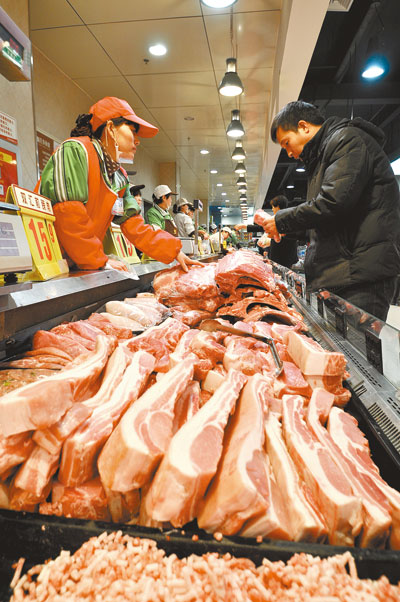
CHINESE consumers have been shocked by recent rises in the price of pork, the nation’s favorite meat, with policymakers also concerned about what impact its costliness will have on inflation and the economy.
Pork prices surged more than 20 percent between March 20 and July 17 this year, according to data provided by the Ministry of Commerce.
A significant reduction in the number of hogs available for slaughter and rising costs in feed and labor have caused the trend, according to analysts.
“Decreasing hog supplies is the major cause of the sharp pork price increases, even though it is the low season for pork sales,” said Li Huiyong, an analyst at Shenwan Hongyuan Securities.
Before the price uptick, pork prices had continuously declined over the past two years, hitting the profits of pig farmers who, in order to mitigate losses, cut down on hog raising, said Liu Xuezhi, an analyst at Bank of Communications.
Liu said the number of hogs available for the market has fallen to a record low this year, which stirred the pork price rebound.
Data from the Ministry of Agriculture showed the number of hogs declined 9.8 percent year on year in May, while the number of sows dropped 15.5 percent.
The recent price surge is a reminder of a typical “pork price cycle” that used to appear, with a price peak every three or four years causing market jitters because of its pertinence to inflation.
In July 2011, pork prices rose nearly 57 percent year on year when monthly inflation hit 6.5 percent, its highest level since Nov. 2007. In 2007, pork prices surged more than 50 percent year on year, feeding an annual inflation growth of 4.8 percent for the year.
Food prices account for about a third of China’s consumer price index (CPI), the main gauge of inflation. Pork, in particular, accounts for 2.9 percent of the CPI.
China’s general inflation has stayed tamed this year. The CPI rose only 1.3 percent year on year in the first half of 2015.
Due to the impact of the pork price cycle, the index is likely to continue rising in the second half because pork will become more expensive later this year when sales pick up, according to analysts. The cooler seasons of autumn and winter are traditionally peak periods for pork sales.
But as general inflation remains well under control, the pork price surge will not cause huge increases in CPI readings, according to Wang Jun, an analyst at the China Center for International Economic Exchange, who predicted annual inflation would rise by no more than 2 percent.
Despite gradual increases in CPI in the July-December period, the annual inflation will be generally lukewarm, and will allow authorities to maintain an easing orientation in monetary policy in the second half, according to Huatai Securities.
The rising pork prices have also led to strong gains in pork-related stocks over the past five trading days in the Chinese A-share market.(Xinhua)
|

